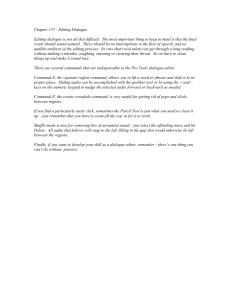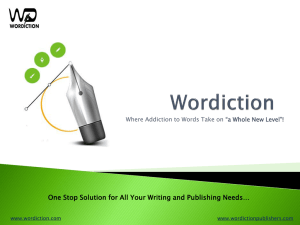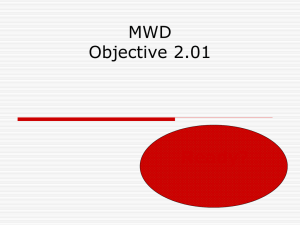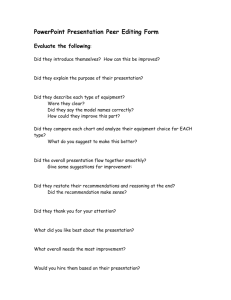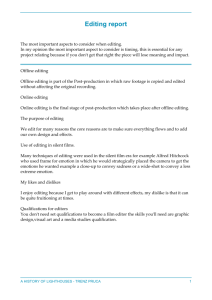DSC_Final_Boccieri
advertisement
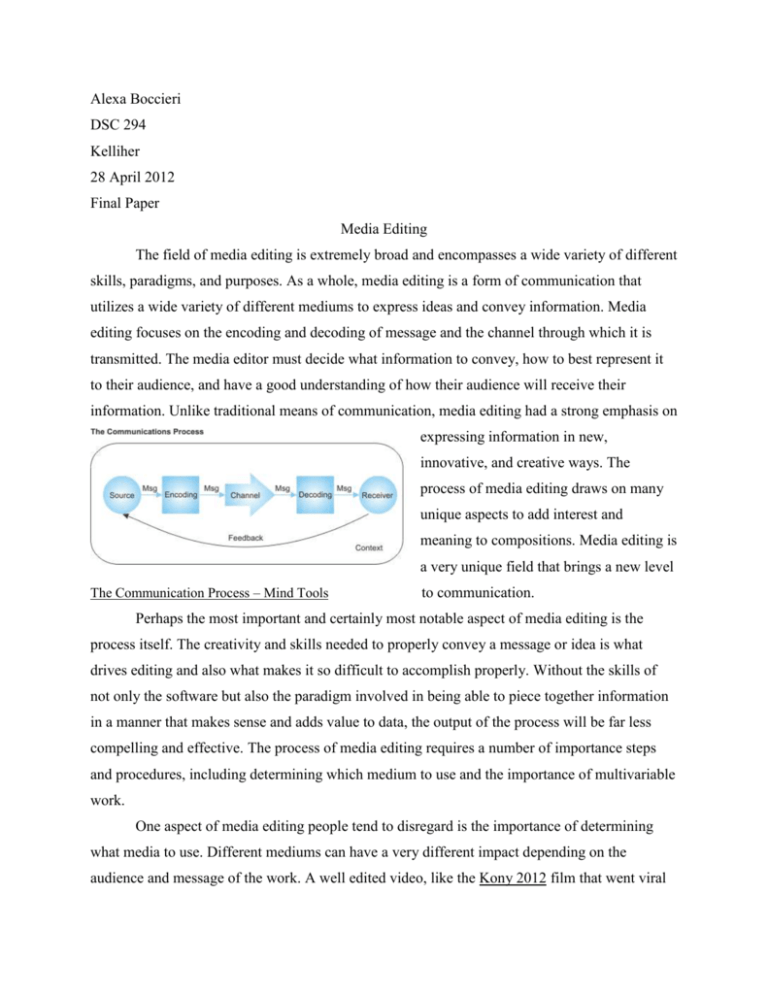
Alexa Boccieri DSC 294 Kelliher 28 April 2012 Final Paper Media Editing The field of media editing is extremely broad and encompasses a wide variety of different skills, paradigms, and purposes. As a whole, media editing is a form of communication that utilizes a wide variety of different mediums to express ideas and convey information. Media editing focuses on the encoding and decoding of message and the channel through which it is transmitted. The media editor must decide what information to convey, how to best represent it to their audience, and have a good understanding of how their audience will receive their information. Unlike traditional means of communication, media editing had a strong emphasis on expressing information in new, innovative, and creative ways. The process of media editing draws on many unique aspects to add interest and meaning to compositions. Media editing is a very unique field that brings a new level The Communication Process – Mind Tools to communication. Perhaps the most important and certainly most notable aspect of media editing is the process itself. The creativity and skills needed to properly convey a message or idea is what drives editing and also what makes it so difficult to accomplish properly. Without the skills of not only the software but also the paradigm involved in being able to piece together information in a manner that makes sense and adds value to data, the output of the process will be far less compelling and effective. The process of media editing requires a number of importance steps and procedures, including determining which medium to use and the importance of multivariable work. One aspect of media editing people tend to disregard is the importance of determining what media to use. Different mediums can have a very different impact depending on the audience and message of the work. A well edited video, like the Kony 2012 film that went viral earlier this year, can convey a large amount of information in a short amount of time and impacts people in a different way than just images or text alone. However, when one is trying to focus on a specific piece of information and wants to convey a lot of information in a small space, those channels might be more valuable, such as in a scientific report or academic journal. Society has ingrained expectations for what different mediums should convey what information, which can limit the amount of experimentation a person can get away with, but also lays down guidelines for what channel one should use to transmit their ideas. For example, most recorded audio that people experience on a daily basis is either music or in some manner information from text based source (audio books, recorded speeches, reading of the news on the radio). While audio is something we experience everyday in our lives and has a large impact on people, it tends not to be the channel of choice for sharing information. As important as the channel of transmission is and the medium selected, the process is far more successful when people also take into account the importance of the idea or information itself. The importance of the channel is directly related to the importance of the information itself, but another aspect of media editing which separates it from general communication is the potential to combine a large amount of data into one space. Including more than one or even two variables in a work can immensely add to the informational value and can help give context to the information. A great example of this would be the Minard maps, which combine a large number of statistics to create a very compelling graphic of the information, both on an intellectual level and an emotional one. Often times motion graphics and graphical statistics use this to their advantage, editing the meaning of textual information into a different media. Including more than one variable in a composition can have not only informational value, but also aesthetic. The work itself, not just the information, can be multivariable in nature, which usually adds interest and uniqueness to piece even if it is not directly trying to convey an informational message but a creative one instead. An example of this is video, which is so impactful because it combines two major variables: audio and visual. It appeals to multiple senses, which makes it more of a stimulus for the person watching it. Other mediums can also take advantage of multiple variables, though on a more specific scale. Visuals use color, shape, and contrast to add more interest to a piece, while audio utilizes tone, tempo, the different notes to provide a greater sense of purpose to the sound. These variables can be used to add information and data, such as in the Minard map (the use of black and tan to differentiate between the two directions of the march) or in many graphical statistics, or it could be used to trigger an emotional response from the receiver/audience that would promote the meaning or purpose of the work. Media editing is a process that requires the creator/editor to be able to work with a large number of variables and data in order to create the most meaningful piece. Throughout the class, I have attempted to integrate these aspects of effective media editing, though there were some cases that came more difficult and other which worked well given the message and the assignment. Of the work completed for the class, I believe the one that most accurately represents the above concepts would be the Layer Tennis composition completed against the work of James Bird. Though we were expected to add a new creative angle to their work, I believe it was also important to keep the feel of the original piece. Another very successful assignment for me was the group video assignment that focused on both giving an introduction for the members and explaining something which is important to us. Perhaps the most difficult piece for me was the audio unit, which depended on a number of variables I had previously had little experience with. Overall, what makes media editing stand out as a new form of communication is the emphasis on creative practice and the expectation of innovative communication methods. The emphasis on skill with new technologies and their everincreasing potential challenges media editors to be both artists and gatekeepers for new information. Media editing teaches many important skills and would be beneficial for everyone to learn at some point in their life.



